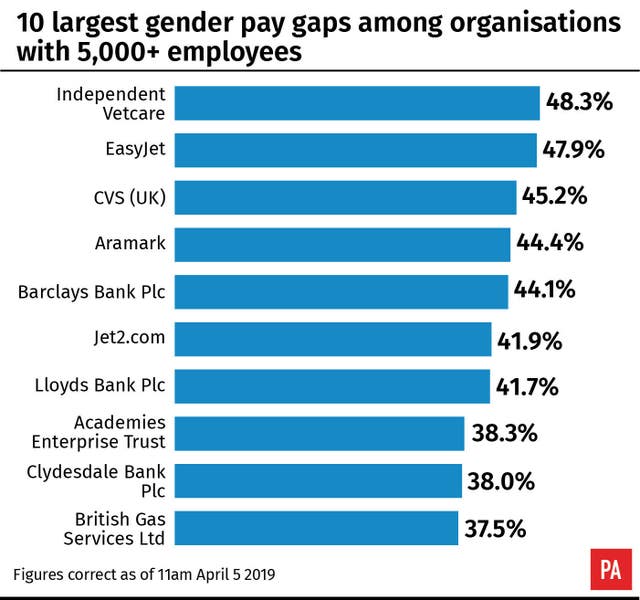
Most organisations meeting a deadline for reporting gender pay figures have showed a gap in favour of men.
Of the 10,450 organisations who had reported their figures by Friday, 78% (8,128) showed a gender pay gap in favour of men while 14% (1,427) showed a gap in favour of women, with the rest reporting no difference.
Some 9,339 employers have so far reported comparable figures for both 2017/18 and 2018/19, of which 4,140 (44%) showed a gap increasing in favour of men, and 742 (8%) showed no change.
High-profile organisations that reported some of the largest pay gaps for 2018/19 include the airline Ryanair (64.4%), the health provider Intrahealth (57.4%) and Sheffield United football club (48.2%).

Employers whose gender pay gap increased in size year-on-year include Huddersfield Town football club (up from 20.9% to 39.6%), the Department for Digital, Culture, Media and Sport (up from 8.2% to 22.9%) and Dyfed-Powys Police (from 8.0% to 22.5%).
The Government Equalities Office estimated that around half of private sector employers have put in place an action plan to tackle their pay gap.
Of 8,424 private firms reporting their data, 3,387 saw their pay gap worsen, 3,736 saw it improve and 645 reported no change, said the Government.
All employers with more than 250 staff had until midnight last night to report gender pay details or face legal action, including fines.
The Equalities and Human Rights Commission said it will now be contacting firms which had not supplied information.
The Chartered Institute of Personnel and Development (CIPD) said there were “marked differences” between regions, with the median gender gap lowest in Scotland at 5.7% and highest in the South East and South West – both 11%.
Chief executive Peter Cheese said: “It’s disappointing that many employers are still not providing a narrative or action plan.
“Organisations that simply provide their numbers are failing to meet the increasing appetite and expectation for transparency amongst all stakeholders, including employees, investors, and regulators.”

TUC general secretary Frances O’Grady said: “Big employers clearly aren’t doing enough to tackle the root causes of pay inequality and working women are paying the price.
“Government needs to crank up the pressure. Companies shouldn’t just be made to publish their gender pay gaps, they should be legally required to explain how they’ll close them, and bosses who flout the law should be fined.”
Carolyn Fairbairn, director general of the CBI, said businesses cannot close the gap by themselves, adding: “Many of the causes lie outside the workplace including a lack of affordable, high-quality childcare and better careers advice.
“Companies and Government working together remains the best way to deliver the long-term, lasting change that’s needed.”
Minister for Women and Equalities, Penny Mordaunt, said: “Actions to tackle the gender pay gap are good for business. That’s why we have produced support to help employers close their gaps.
“We recognise that in order to close the gap entirely we still need a much wider cultural change, that is why we have introduced a range of initiatives to tackle the drivers of the gap, including shared parental leave and spending around £6 billion on childcare support.”
The Equality and Human Rights Commission said 95% of private employers believed to be in scope of the regulations had reported their second year gender pay gap data. Approximately 440 have failed to do so and the commission will be writing to these organisations requiring them to report urgently.
Chief executive Rebecca Hilsenrath, said: “Gender pay gap reporting is not optional. It is a legal requirement and there’s simply no excuse for employers failing to comply with the regulations this year. We will be taking enforcement action against all organisations that have not filed by the deadline requiring them to report immediately.
“Employers that don’t report on time not only risk enforcement action and potential financial penalties, they are letting down the women who work for them. They should be prepared for an unhappy workforce and potential reputational damage.
“The causes of the gender pay gap are complex and deeply entrenched. Meaningful change will take time and concerted effort, with some changes potentially increasing gaps in the short term, such as employing more women at junior levels before they rise into more senior positions.
“That is why it is vital that employers publish action plans to explain their figures and highlight where they will be targeting any inequality in their workplace.”


Comments: Our rules
We want our comments to be a lively and valuable part of our community - a place where readers can debate and engage with the most important local issues. The ability to comment on our stories is a privilege, not a right, however, and that privilege may be withdrawn if it is abused or misused.
Please report any comments that break our rules.
Read the rules here